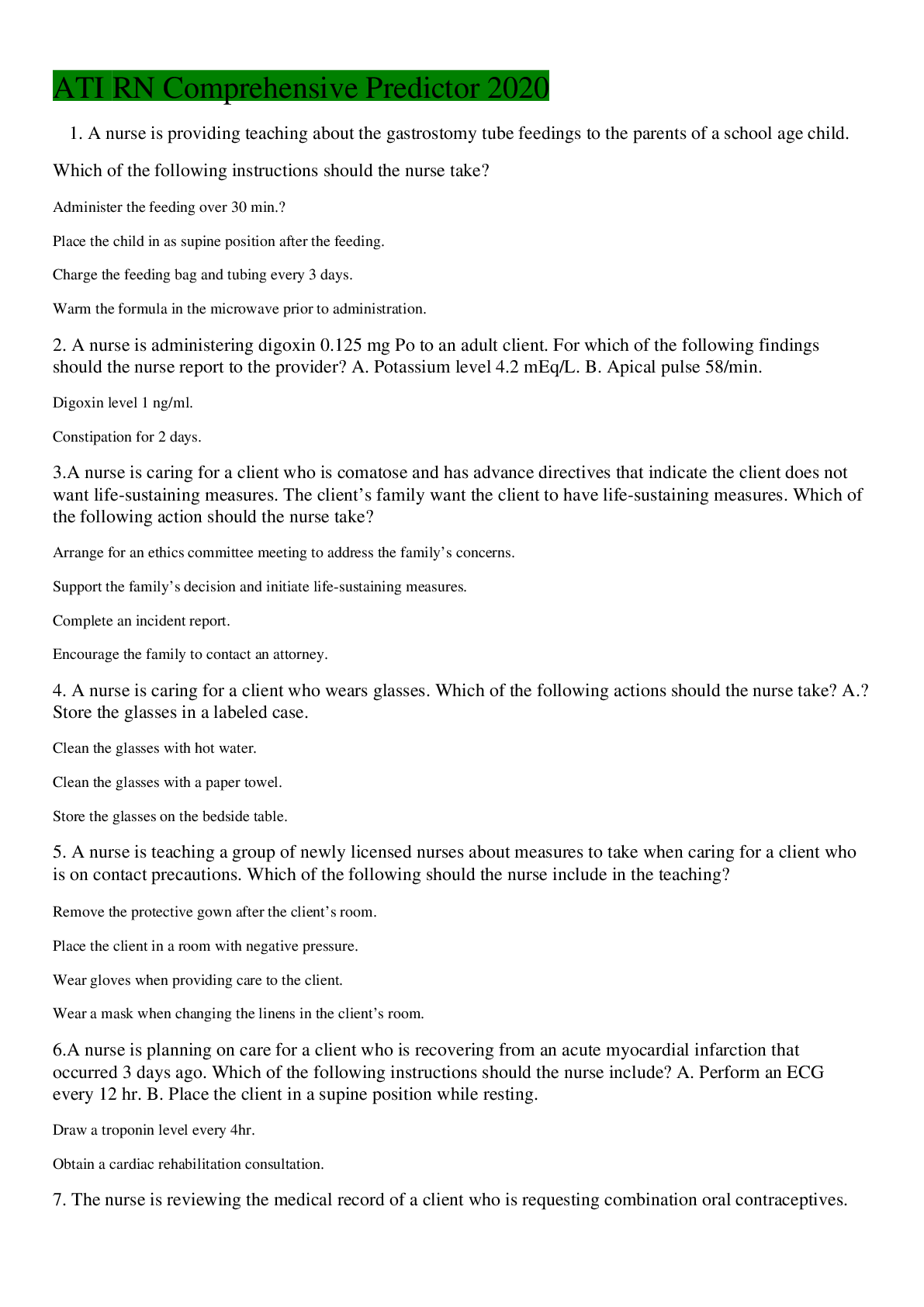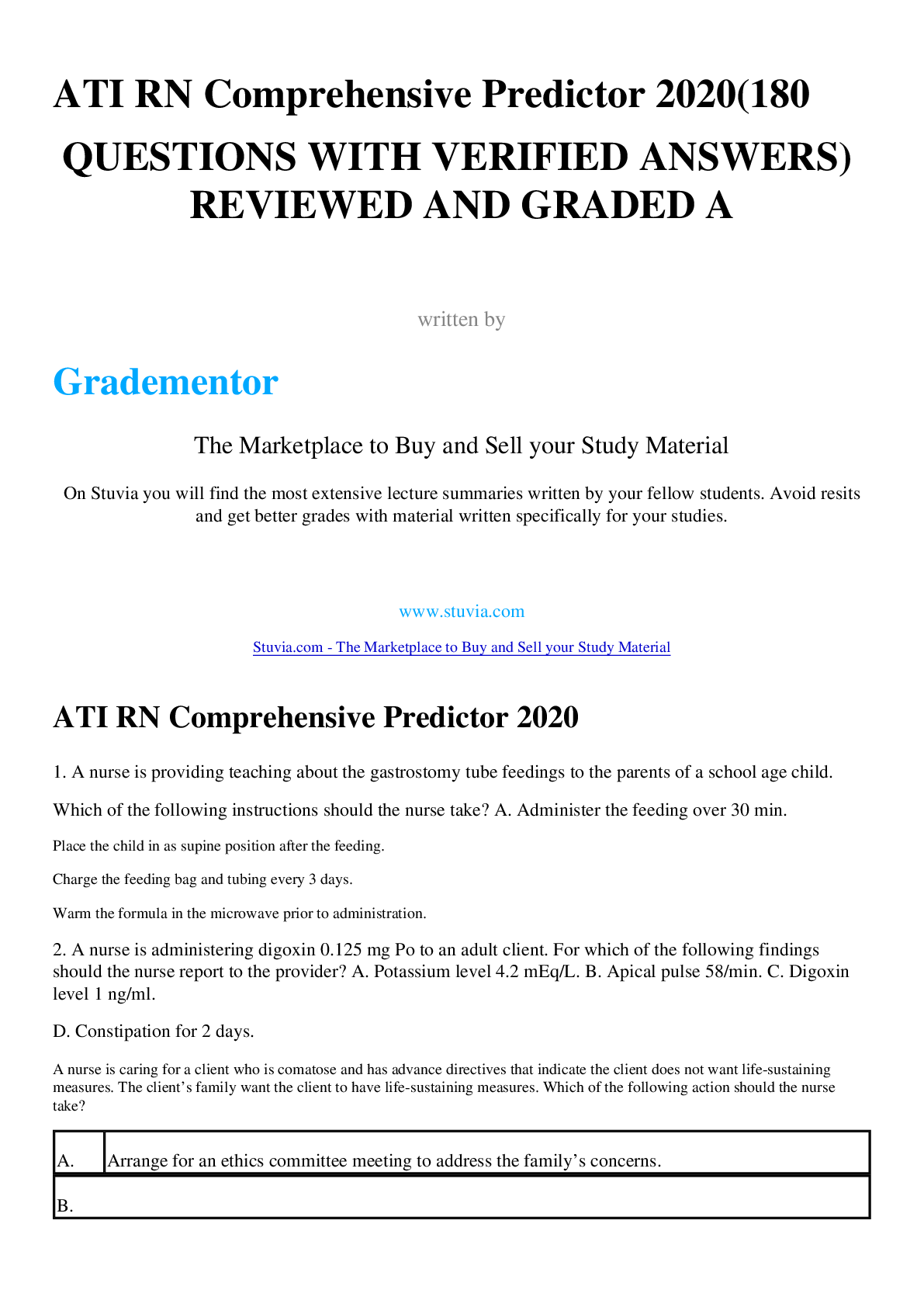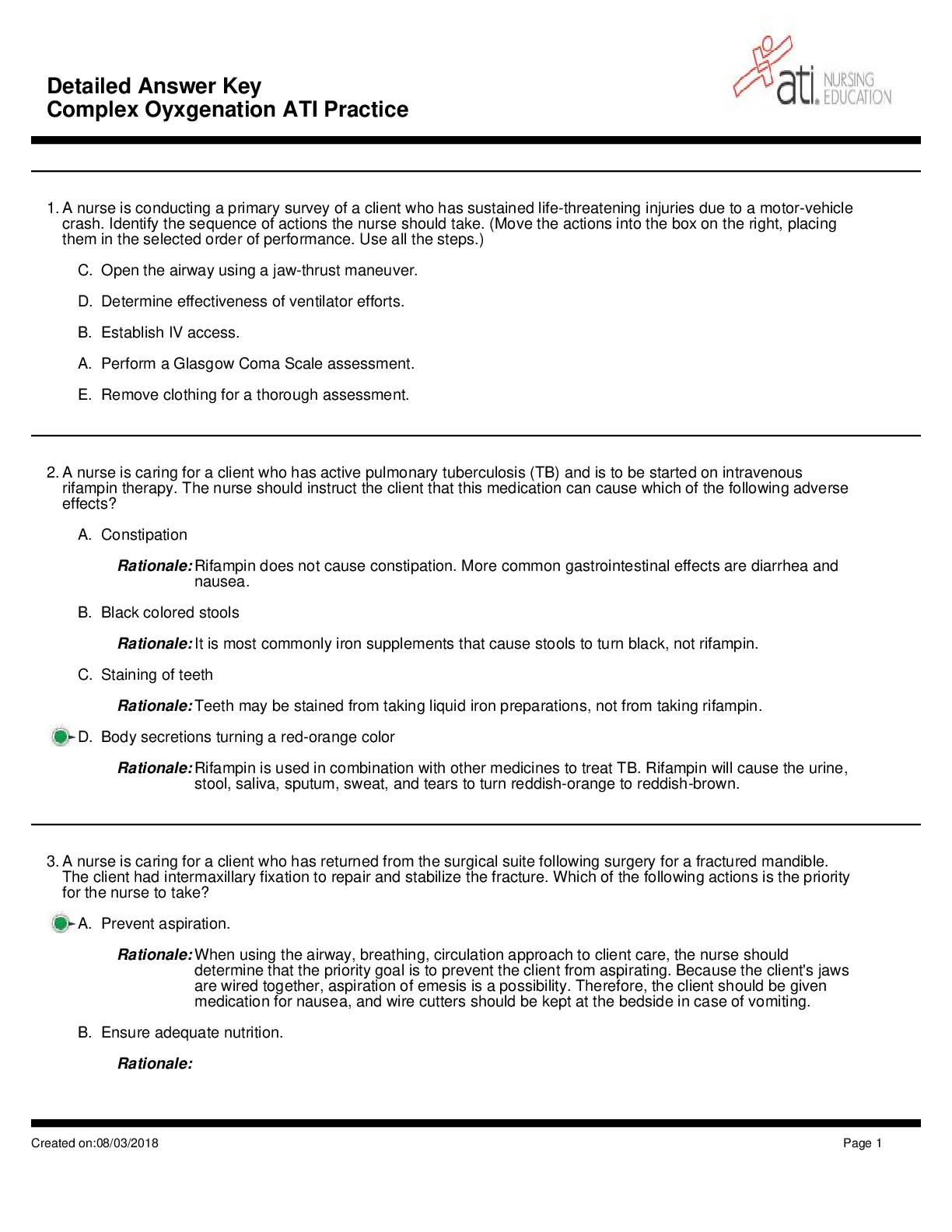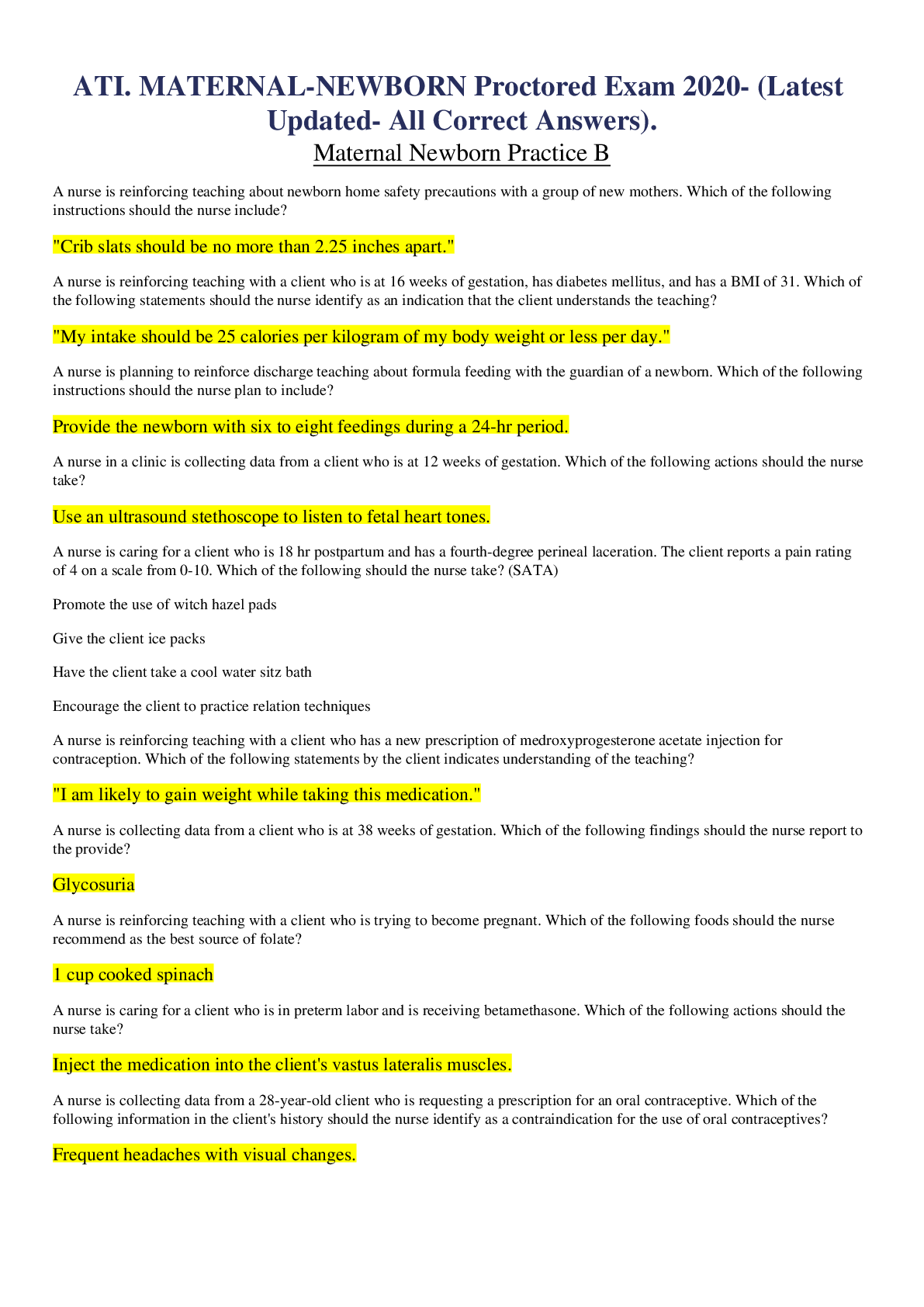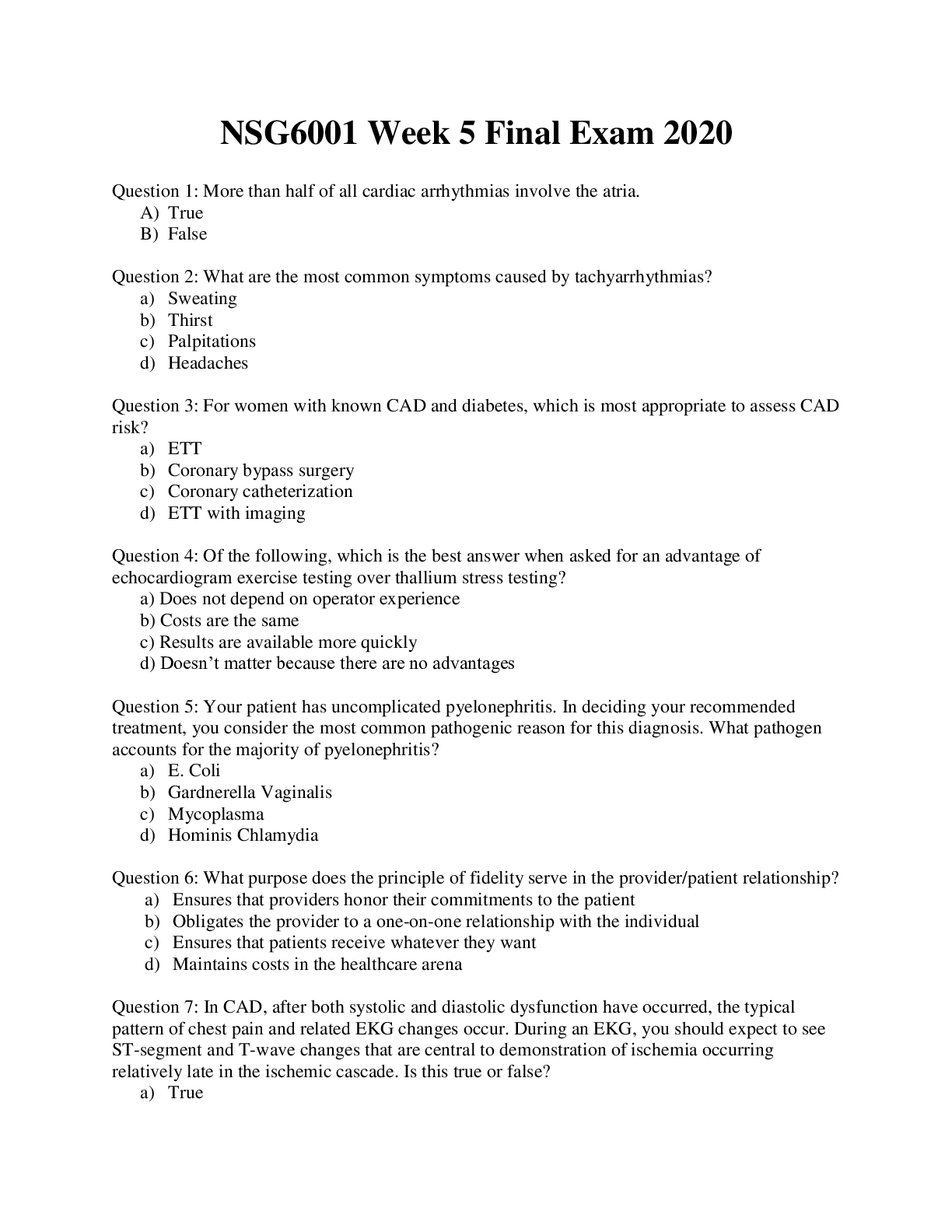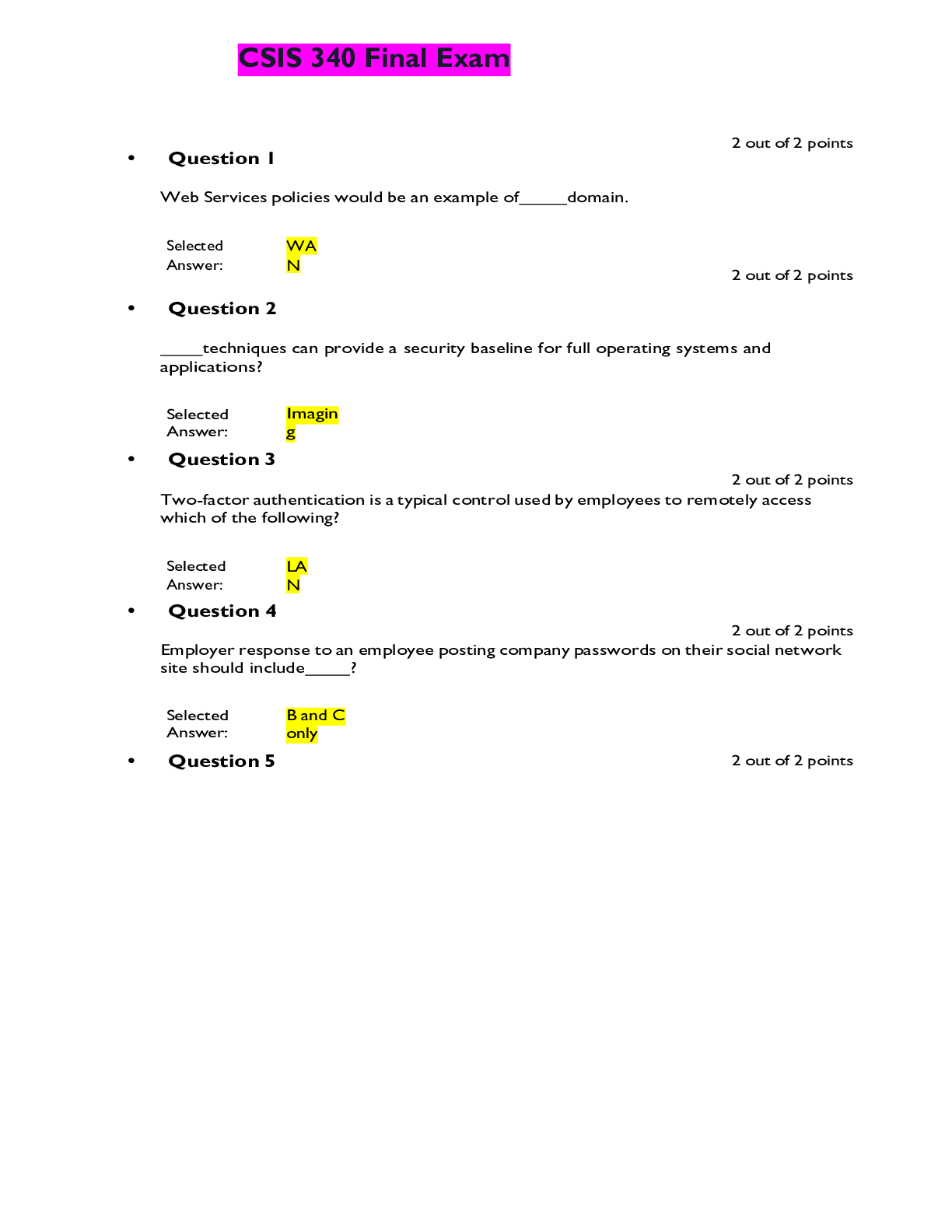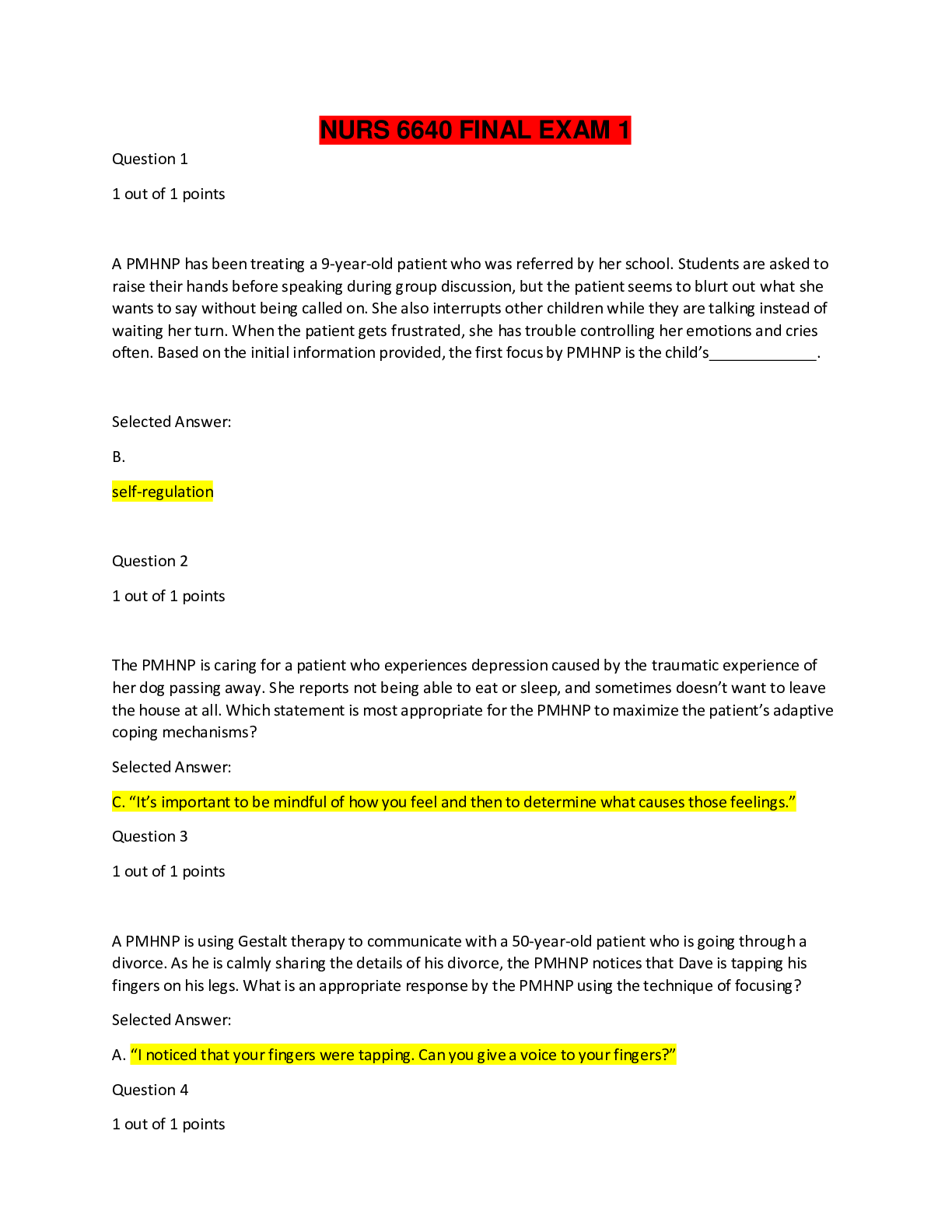Scrum Product Owner Exam 73 Questions with Verified Answers,100% CORRECT
Document Content and Description Below
Scrum Product Owner Exam 73 Questions with Verified Answers What is scrum? - CORRECT ANSWER Scrum is an iterative software engineering process to develop and deliver software shared division o... f labor - CORRECT ANSWER where each team member feels responsible for—and is able to work on—any aspect of the project. TQC - CORRECT ANSWER was designed to heighten the entire organization's sensitivity toward simultaneous quality and productivity improvement, market orientation, cost reduction, and work simplification to achieve TQC goals - CORRECT ANSWER everyone in the organization had to learn the basics of techniques like statistical quality control and value engineering. • Three Scrum Roles - CORRECT ANSWER The Scrum Product Owner, the Scrum Team, and the Scrum Master. Five Scrum Events (Scrum Rituals) or Ceremonies - CORRECT ANSWER Scrum Grooming (Backlog Refinement) Meeting, Sprint Planning Meeting, Daily Scrum Meeting, Sprint Review Meeting, and Sprint Retrospective Meeting Product Backlog (Scrum Backlog) or Scrum Product Backlog: - CORRECT ANSWER An artifact that is used to manage and prioritize all of the known requirements of a Scrum project. Sprints: - CORRECT ANSWER Cycles of work activities to develop shippable software product or service increments. Sprint Backlog: - CORRECT ANSWER An artifact to keep track of requirements committed by the Scrum teams for a given Sprint. steps to meetings - CORRECT ANSWER Step 1. Inspect is analog to Sprint Review Meetings and Sprint Retrospective Meetings. • Step 2. Adapt is analog to Sprint Planning Meetings and Backlog Refinement Meetings. • Step 3. Learn is analog to Daily Scrum Meetings. • Step 4. Restart is analog to the closure of a sprint and the start of a new sprint. inspect and adapt - CORRECT ANSWER Step 1. Inspect: We do our best to grasp the current status of the project with our current level of knowhow and understanding about it. • Step 2. Adapt: We define a direction and vision about the next steps of our project and then strategize and execute our vision. • Step 3. Learn: We carefully observe, learn, and teach each other while we do so. We continuously log what works and what doesn't work while we do our work. • Step 4. Restart: Start over from Step 1 again. Scrum Value #1. Courage - CORRECT ANSWER There are times when doing the correct thing to serve the best values and benefits for our clients are not the easiest. In such moments, scrum master, scrum product owner, and the scrum team members should remember their duty and obligation. That's to build the best possible products and services in their particular business and information technology domain. To be better than mediocre, a scrum team should sooner or later face difficult decisions that won't make everyone happy in their particular ecosystem of stakeholders. To deal with this, all members of the scrum team should remember what they learned during their scrum certification training. They should remember to be courageous, and they should master to decide and act courageously. Scrum Value #2. Focus - CORRECT ANSWER With the scrum framework, when you hear the value focus, you should be thinking about two things: • Identification of correct work: What tasks are necessary to deliver the goals of my sprint? What are essential to developing the best software products and services for my clients so that they will be pleased with my work? • Prioritization: What tasks should I be working on next? Each moment in time, there is one critical question that the entire scrum team, including scrum master and product owner, must be answering. This question is: "What are the most important things we should be doing at the moment to fulfill reasons of why an employer hired us in the first place?" Scrum framework has several built-in events (rituals) to ensure the reasonable prioritization of user stories and tasks. According to the scrum process, the prioritization of user stories and their associated tasks should have a continuous priority. So we make sure that the scrum team works on the right things in the correct order. Some of the built-in scrum ceremonies (scrum events) to prioritize our work and adjust our focus are: - CORRECT ANSWER • Scrum Grooming (Backlog Refinement) Meeting: Grooming Meeting solely focuses on prioritization for Product Backlog to prepare it before the upcoming Sprint Planning Meeting. • Sprint Planning Meeting: These meetings help us see the dependencies and correct order of work to deliver our user stories. • Daily Scrum Meeting: Daily Scrum (Daily Stand-Up) Meeting supports us to set the tone of an upcoming workday. We must direct our focus on where it's most required. • Sprint Review Meeting: Sprint review meeting indirectly shows us where the emphasis of the 22 scrum team must be channeling to have more successful reviews in the future. • Sprint Retrospective Meeting: These meetings support the scrum team to prioritize what aspects of their engineering process must be first improved. Scrum Value #3. Commitment - CORRECT ANSWER Without the commitment of scrum master, scrum product owner, and the scrum team, there is no possibility to deliver outstanding results with software. In the world of the scrum software development process, most people translate the commitment value as the agreement and confinement of goals of given sprint deliverables. Although this entirely makes sense, that understanding is not flawless. Whenever you hear the word "commitment" within the context of scrum values; what you should remember is the word: "obsession". To be successful in software engineering and, in life and business, you should become obsessed with your goals. So in the context of the scrum process, you should become obsessed with creating marvelous software for your clients to solve their problems. Why are commitment and the associated obsession with scrum goals so important? Because without the obsession with the team's mission to build and deliver astonishing software, each time the scrum team encounters a non-trivial impediment, your work will slow down and stall. 23 Then the scrum master and the scrum team will start creating explanations to justify and legitimize for scrum product owner why they're unable to deliver sprint goals. Excuses should have no more room in your team if your goal is to become a better than an average scrum team. Only with an enormously high level of dedication, it's relatively more comfortable and fulfilling to solve the problems of our clients and help and build value for them with software. Scrum Value #4. Respect - CORRECT ANSWER Regardless of their age, gender, race, belief, experience, competence, opinions, and work performance, every member of a scrum team must respect and count on each other. This respect is not only confined within the boundary of the scrum team. Moreover, every internal or external IT and business stakeholder who interacts with the scrum team is utterly respected and welcomed by a scrum team. Experienced team members must pay attention in order not to invalidate the willingness of the contribution from less experienced team members. It's particularly crucial to properly receive and answer opposite opinions that the majority of the group do not agree with. Scrum Value #5. Openness - CORRECT ANSWER The scrum value "openness" is often one of the primary differentiators between an average and high-performer scrum team. It would help if you resembled the openness capability of a scrum team to the vast ability of a collection of openminded individuals. They're creative, innovative, intellectual, honest, direct, and humble. In the scrum software engineering and delivery process, there is no inappropriate opinion, decision, and action. 24 The only condition is that they must be transparent, and they should aim to contribute to the joint mission of the scrum team. It doesn't mean that every decision and action must necessarily accelerate the outputs of the scrum team, and they should result in substantial success stories. Thanks to openness and courage values, the scrum software development group is not afraid of making mistakes. They see their errors and less than optimal outcomes as vital chances to meaningfully improve their overall productivity and quality of work. Some of the problems he specifically mentioned related to his software project configuration are: - CORRECT ANSWER Differences in working styles among scrum team members, • Timezone differences, • Cultural misfits, and • Language constraints. Definition of Done (DoD). - CORRECT ANSWER DoDs specify the expected outcome in terms of functional and non-functional requirements, design, coding, unit testing, end-user validations, documentation, and so on. DoDs are defined in the levels of both user stories and tasks. DoDs of user stories focus on functional and non-functional client requirements, whereas DoDs of tasks focus on the desired working activities from the Scrum Team members. Studies have shown that Scrum has the following positive effects in practice:` - CORRECT ANSWER More frequent code deployments, • Faster lead time from committing to deploying code, • Faster mean time to recover from downtime, • Lower change failure rate, • Better product quality, • Reduced or identical costs compared to preScrum deployment, • Improved productivity and throughput, • Improved code and operational reliability, • Enhanced organizational performance and client satisfaction, • Improved market penetration, market share, and profitability of organizations, • Improved market capitalization growth, • Improved motivation of employees. Characteristics of a Scrum Team - CORRECT ANSWER • Team members share the same norms and rules, • The Scrum team as a whole is accountable for the delivery, • The Scrum Team is empowered, • The Scrum Team is working as autonomous as it is possible, • The Scrum Team is self-organizing, • The skills within the Scrum team are balanced, • A core Scrum Team is small and has no subteams, • The Scrum Team members are dedicated to their teams with 100% capacity, • Scrum Team members are collocated, and they ideally share the same room. Just a few examples of such norms and rules are: - CORRECT ANSWER The goal, scope, duration, location, participants and outcomes of Scrum Rituals (Events), • Required level of details to write clear, concise and unmistakable Definition Of Dones (DoDs), • Guidelines to prioritize and estimate user stories and tasks, • Guidelines, procedures and the level of details to create living documents, 48 • Tools to use and tools not to use (remember, sometimes less is more), • Coding standards, • Tools and guidelines to build/perform manual/ automated tests and ensure quality, • The process to resolve bugs, • The process to handle change requests, • The process to prepare to product increment demonstrations during Sprint Review Meetings, • The process to handle the outcomes of each Scrum Ritual (Event), • Frequency, depth, and duration of Backlog Refinement Meetings. The only way to find this out is to test, learn, and adapt. If you find out that a team of 13 people cannot perform well enough, - CORRECT ANSWER then these Scrum Teams need to be split into two teams. These Scrum Teams should closely align, and they correlate their goals and user stories. Besides that, they work independently. Responsibilities of the Scrum Team - CORRECT ANSWER • They have to breakdown the user stories, create tasks, define priorities and estimates, and they self-organize the implementation. In other words, they have to create, process, and deliver the Sprint Backlog. • They have to perform Daily Scrum Meetings. • They have to ensure that at the end of the Sprint, potentially shippable product increment is delivered and demonstrated. • They have to update the status and the remaining work efforts for their tasks to allow the creation of a Sprint Burndown Diagram. Essential tasks of a Scrum Master are: - CORRECT ANSWER • To establish the Scrum Framework in his or her business and IT ecosystem, • To act as a change agent and support the adaptation of existing processes to maximize productivity of the Scrum Team. • To coach the Scrum Team to understand and live the values of the Scrum Framework, • To ensure efficient and close collaboration between the Scrum Product Owner and the Scrum Team, • To remove impediments which hinder the continuity of work, • To lead progress of work by serving, • To moderate the Scrum Rituals (Scrum Events). • To guard the Scrum Team from external interference and interruptions while the team does work it has originally committed for a Sprint. if the ongoing Sprint does not make any business and/or technical sense to continue, - CORRECT ANSWER it can be canceled, and a new Sprint can be planned. The Scrum Master helps by removing impediments that block or slow down the progress of work. Examples of removing impediments could be: - CORRECT ANSWER • To arrange support, resources, • To find missing knowhow, and • To do hands-on work to help the Scrum Team Members. The Scrum Master hosts and moderates the Scrum Retrospective Meeting, - CORRECT ANSWER and his or her job is then to facilitate, control and measure the change of the identified shortcomings. The Scrum Framework defines several meetings that have to be organized and facilitated by the Scrum Master: - CORRECT ANSWER Scrum Grooming (Backlog Refinement) Meetings, • Sprint Planning Meetings, • Daily Scrum Meetings, • Sprint Review Meetings, and • Sprint Retrospective Meetings The Scrum Product Owner is a central role within the Scrum Framework - CORRECT ANSWER That role unifies product and project management tasks, and it's also firmly integrated with software development and delivery. Product Owner - CORRECT ANSWER He or she represents the end customers and/or other stakeholders and is responsible for maximizing the value of the product by ensuring that the Scrum Team delivers the right work at the right time. The Scrum Product Owner decides the software requirements provided for a specific software version, and when the software will be released. She represents functional and nonfunctional demands from end-users. That means that the Scrum Product Owner has to work very closely with the Scrum Team and coordinates their activities over the entire lifecycle of the project. No one else is allowed to impose the Scrum Team to work for a different set of priorities. Essential tasks of a Scrum Product owner are: - CORRECT ANSWER • To manage and clarify project requirements, • To guide releases and to ensure return on investment (ROI), • To closely work with the Scrum Team and enable it to deliver the correct work on time, • To manage stakeholders and their expectations, • To manage the Scrum Product Backlog. The Scrum Product Owner is the only person allowed to own the contents of the Scrum Product Backlog. That means he or she needs to: - CORRECT ANSWER • Create, maintain and clearly describe user stories in the Scrum Product Backlog, • Prioritize user stories to accomplish business goals and fulfill the mission of software product, • Ensure that the Scrum Team correctly comprehends and implements the user stories in the Scrum Product Backlog. - CORRECT ANSWER Product owner - CORRECT ANSWER role in scrum team, has the vision for the implementation of the software that needs to be delivered, the bridge between the customer and the scrum team, good understanding from the customer, leader for the product scrum framework - CORRECT ANSWER based on the agile approach for the implementation of software projects; we deliver requirements into chunks what do you expect from this job as a product owner - CORRECT ANSWER must have to behave like a leader and owner of the product, any change may not be approved without your approval for the product, you are the bridge between the customer and the scrum team and should have the clear visibility and understanding of the product that needs to developed Do you think its a good idea to have one person performing both the scrum product owner role and the scrum master role - CORRECT ANSWER I don't think it's a good idea, their roles and responsibilities are totally different, scrum master knows best practices and facilitator for the scrum team, the product owner owns the product and has clear vision and is leading the team, there are two different roles. I would say it's not a good idea, that the roles be performed by a single person. Do you have experience working with a scrum framework - CORRECT ANSWER yes, talk about positions and experience, What other product discovery frameworks have you worked with - CORRECT ANSWER waterfall Who do you consider to be the most important product stakeholder - CORRECT ANSWER the customer is the most important product stakeholder, this is the person who has the requirement, where are the funds and resources coming from, lifeline of the product how much time do you give to understanding customer needs and user research during product discovery - CORRECT ANSWER the most time should be given, everything is built on the customer requirements, only when you understand the requirements, will you be able to develop the right model, but requirements are consistently changing. You do need to understand the requirement properly, if not you cannot build it. There will be issues if there are any gaps that you don't understand Uncooperative stakeholders - CORRECT ANSWER every person has weakness and strengths. you must have to understand the person and behave like you know, do you have experience working in a scrum team - CORRECT ANSWER yes, crystal clear and appropriate how do you explain your marketplace knowledge to the scrum team - CORRECT ANSWER use google and google trends How do you go about updating the team on the product and market situation? Where do you source information? - CORRECT ANSWER utilize market experts, google, google trends, collegues How would you redesign our product? - CORRECT ANSWER product manager vs product owner - CORRECT ANSWER The Product Manager drives the strategic vision for the product. The Product Owner is the tactical ground force looking to build and refine the product. sprints typically last for - CORRECT ANSWER 1-2 weeks kanban boards - CORRECT ANSWER often used to visually show tasks that need to be done, are in progress, or are completed Release Management - CORRECT ANSWER The Scrum Product Owner is responsible for reaching the project goals. He or she creates and maintains the release plan and decides about deliveries, end-user functions, and the order they need to be delivered. Scrum Product Owners often manage the costs and budget of Scrum Teams too. They collaborate with the Scrum Team members to fine-tune, prioritize, and estimate user stories. Stakeholder Management - CORRECT ANSWER External stakeholders should not directly bring their demands to the Scrum Team members. Instead, the Scrum Product Owner should collect and assess required functionalities with the stakeholders (for instance, with internal clients, representatives of external clients or end-users). The Scrum Product Owner combines, filters and initially prioritizes these user stories before he or she discusses them with the Scrum Team. Collaboration With The Scrum Team - CORRECT ANSWER For a successful project, the Scrum Product Owner and the Scrum Team must work very closely. The Scrum Product Owner is responsible for ensuring that the Scrum Team members are informed and aligned about the aimed goals of software they're building. During Sprint Review Meetings, the Scrum Product Owner is responsible for inspecting, accepting, or declining deliverables of the Scrum Team. the scrum team, implements the software - CORRECT ANSWER They jointly decide the number of requirements that they can undoubtedly deliver during a particular product increment called "Sprint". A high-performer scrum team has most of the software engineering skills typically in it. Software developers, architects, testers, database administrators, and team members from all other roles work together Now their job is to build the best possible software to deliver the requirements of their scrum product owner. Characteristics of scrum teams are: - CORRECT ANSWER Characteristics of scrum teams are: • Empowered and Autonomous, • Cross-functional, • Self-organized and small, • Full-time participants, • Working in the same room, • One for all, all for one. The goal of any reliable process should be to avoid this potential conflict that impacts the functional and tactical administration of the work that the Scrum Team performs. - CORRECT ANSWER no project manager The entries in the Scrum Product Backlog are often written in the form of User Stories. - CORRECT ANSWER A User Story tells a short story about the requirements of someone while he or she is using the software product we are building. user stories - CORRECT ANSWER It has a name, a brief narrative, and acceptance criteria for the story to be counted as completed. The advantage of user stories is that they precisely focus on what the user needs and wants without going into the details on how to achieve them. How to achieve them will be the job of the Scrum team at a later stage, A well known and reliable template is: for user stories - CORRECT ANSWER As an [actor], I [want/must] [action] so that [achievement] Or in a shorter version: As an [actor], I [want/must] [achievement] The Actor is the owner of the user story. - CORRECT ANSWER That is often a user, but it is advisable to be more specific. By using particular actors such as an administrator, logged in customer, or unauthenticated visitor or so on, user stories become distinctive. So they set requirements into a proper context everyone can understand. The Action is what the Actor wants to do - CORRECT ANSWER If it is a mandatory requirement, it can be prefixed as must. Otherwise, it's prefixed as want. The Achievement is what the Actor wants to achieve by performing the Action. - CORRECT ANSWER That's the Actor's envisioned business result or a functional technical component that emerges once the Action is completed. All user stories within the Scrum Product Backlog have to be estimated to allow the Scrum Product Owner to prioritize them and plan releases. - CORRECT ANSWER That means the Scrum Product Owner needs a reliable assessment of how much the delivery of each user story will take. Nevertheless, it is recommended that the Scrum Product Owner does not interfere with the estimations that the Scrum Team performs. So the Scrum Team delivers its estimates without feeling any pressure from the Scrum Product Owner. The Scrum Framework itself does not prescribe a way for the Scrum Teams to estimate their work. The teams who rely on the Scrum Framework do not deliver their estimates of user stories based on time or person-day units. - CORRECT ANSWER Instead, they provide their estimates by using more abstract metrics to compare and qualify the effort required to deliver the user stories. Common estimation methods include: - CORRECT ANSWER Numeric sizing (1 through 10), • T-shirt sizes (XS, S, M, L, XL, XXL, XXXL), or • the Fibonacci sequence (0, 1, 2, 3, 5, 8, 13, 21, 34, etc) The Scrum Team members must share a common understanding and consensus of the unit of estimations they use so that every member of the team feels and acts comfortable with it. When using Planning Poker®, the social proof influence among the Scrum Team members are minimal. Therefore, the Scrum Team produces more accurate estimation results. - CORRECT ANSWER What you need to play Planning Poker® game is straightforward: • The list of features to be estimated • Decks of numbered cards. A typical deck has cards showing the Fibonacci sequence, including a zero: 0, 1, 2, 3, 5, 8, 13, 21, 34, 55, 89. Other similar progressions are also possible. The reason for using the Fibonacci sequence is to reflect the uncertainty in estimating larger items. It would be a waste of time to discuss if a user story should have a size of 19, 20 or 21. And yet, it's relatively easier to decide if the user story fits better to the size 13 or 21. A high estimate could mean that the Scrum Team members have not very well understood the user story yet. So they can attempt to secure extra capacity for contingency before their commitment to this user story. Alternatively, that could also mean that the user story should be broken down into multiple smaller user stories. Scrum teams can usually estimate smaller and clearer user stories with higher confidence. The scrum product owner presents the story to be estimated - CORRECT ANSWER the scrum team asks questions, and the scrum product owner articulates the user story in more detail. If the scrum team has to assess many user stories, estimates can be time-boxed in a way that the scrum team does not spend more than a few minutes for each user story. If the team cannot still estimate a user story in a given time-box, then this could be a signal to which the scrum product owner needs to pay attention. this signal indicates that either the end-user requirement or the user story or both of them are not clear enough, so they need to be rewritten. - each member of the scrum team privately chooses the card representing the estimation - after everyone has selected a card, all selections are revealed - People with high and low estimates are asked to explain their assessment because they may have thought something that the majority of the scrum team members have been unable to see - another estimation is done for this particular user story until the team reaches a consensus for an estimate - the scrum team repeats the game until they estimate all user stories Definition of done (DOD) - CORRECT ANSWER In the Scrum framework, the factors which define when a feature is complete and when it meets the required quality standards are set by Definition of Done (DoD). DoDs - CORRECT ANSWER As it was clarified before in this material, DoDs specify the expected outcome in terms of functional and non-functional requirements, design, coding, unit testing, end-user validations, documentation, and so on. DoDs are defined in the levels of both user stories and tasks. DoDs of user stories - CORRECT ANSWER focus on functional and non-functional client requirements, whereas DoDs of tasks focus on the desired working activities from the scrum team members The Scrum Team is not allowed to close the user stories, and obviously, the tasks that do not fulfill their DoDs. - CORRECT ANSWER Definition of Done (DoD) is used to decide whether a User Story from the Sprint Backlog is complete or not. DoD is a comprehensive checklist of required activities to ensure that only truly completed features are delivered, not only in terms of functionality but in terms of quality as well. The norms which a Scrum Team uses to define DoDs may vary from one team to another, but it must be consistent within a given Scrum Team. There are usually different DoDs at various levels: - CORRECT ANSWER • DoD for a Project/Product (In the project goals) • DoD for a Release (In the release goals) • DoD for a Sprint (In the sprint goals) • DoD for a User Story (In the User Story) • Dod for Tasks (In the task) One more essential thing to keep in mind here is that a DoD is neither static nor indisputable. - CORRECT ANSWER During the course of a project, a release, or a sprint, a DoD can be challenged by anyone from the Scrum team or other business and IT stakeholders. As long as the proposed changes of a DoD makes sense and they're brought up to bring the project to success, the Scrum Team and the Scrum Product Owner should be openminded to listen to those proposals and implement them when and where necessary. [Show More]
Last updated: 9 months ago
Preview 1 out of 12 pages
Instant download
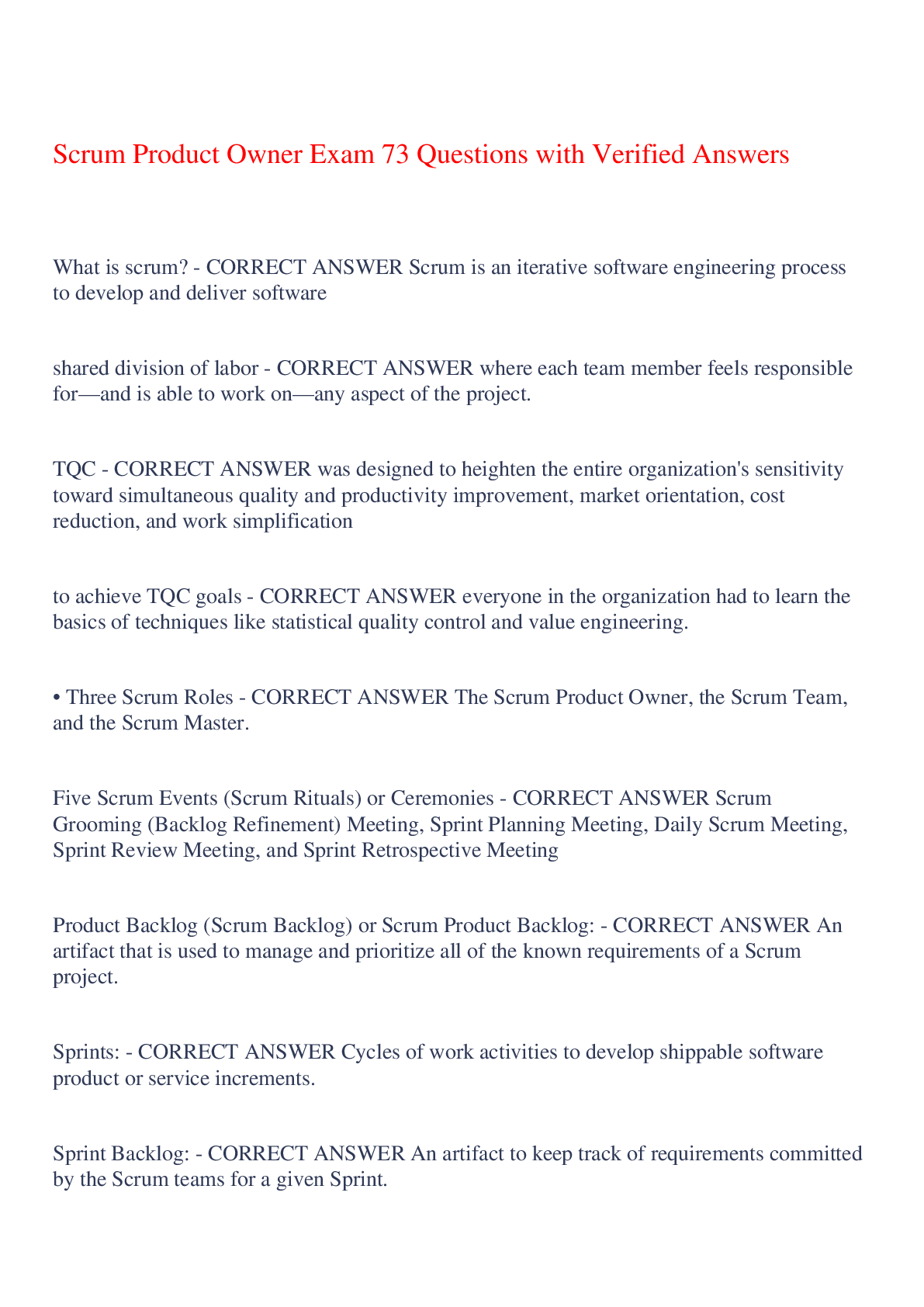
Buy this document to get the full access instantly
Instant Download Access after purchase
Add to cartInstant download
Reviews( 0 )
Document information
Connected school, study & course
About the document
Uploaded On
Aug 27, 2023
Number of pages
12
Written in
Additional information
This document has been written for:
Uploaded
Aug 27, 2023
Downloads
0
Views
32













